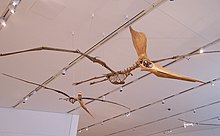| Caelidracones Temporal range: Middle Jurassic–Late Cretaceous,
| |
|---|---|

| |
| Replica of Geosternbergia sternbergi skeletons, female (left) and male (right) | |

| |
| Skeletal reconstruction of Tropeognathus mesembrinus in the National Museum of Brazil | |
| Scientific classification | |
| Domain: | Eukaryota |
| Kingdom: | Animalia |
| Phylum: | Chordata |
| Order: | †Pterosauria |
| Clade: | †Pterodactyliformes |
| Clade: | †Caelidracones Unwin, 2003 |
| Subgroups[1] | |
The Caelidracones is a group of pterosaurs.[2]
The clade Caelidracones was defined in 2003 by David Unwin as the group consisting of the last common ancestor of Anurognathus ammoni and Quetzalcoatlus northropi, and all its descendants.[3]
The name Caelidracones means "sky dragons" from Latin caelum, "heaven", and draco, "dragon" and is a reference to Harry Govier Seeley's 1901 book, Dragons of the Air.
Classification[edit]
In Unwin's original classification, the Caelidracones were considered the sister group of the Dimorphodontidae within the Macronychoptera and consist of the Anurognathidae and the Lonchognatha.[3] More recent studies of pterosaur relationships have found anurognathids and pterodactyloids to be sister groups, which would limit Caelidracones to just those two clades.[1]
Below is a cladogram showing the results of a phylogenetic analysis presented by Longrich, Martill, and Andres, 2018. This study found the two traditional groupings of ctenochasmatoids and kin as an early branching group, with all other pterodactyloids grouped into the Eupterodactyloidea.[4]
| Caelidracones | |
References[edit]
- ^ a b Andres, B.; Myers, T. S. (2013). "Lone Star Pterosaurs". Earth and Environmental Science Transactions of the Royal Society of Edinburgh. 103 (3–4): 383–398. doi:10.1017/S1755691013000303. S2CID 84617119.
- ^ "†unranked clade Caelidracones Unwin 2003 (pterosaur)". Paleobiology Database. Fossilworks. Retrieved 27 April 2016.
- ^ a b Unwin, D. M. (2003). "On the phylogeny and evolutionary history of pterosaurs". Geological Society, London, Special Publications. 217 (1): 139–190. doi:10.1144/GSL.SP.2003.217.01.11. S2CID 86710955.
- ^ Longrich, N.R., Martill, D.M., and Andres, B. (2018). Late Maastrichtian pterosaurs from North Africa and mass extinction of Pterosauria at the Cretaceous-Paleogene boundary. PLoS Biology, 16(3): e2001663. doi:10.1371/journal.pbio.2001663














Well, that’s interesting to know that Psilotum nudum are known as whisk ferns. Psilotum nudum is the commoner species of the two. While the P. flaccidum is a rare species and is found in the tropical islands. Both the species are usually epiphytic in habit and grow upon tree ferns. These species may also be terrestrial and grow in humus or in the crevices of the rocks.
View the detailed Guide of Psilotum nudum: Detailed Study Of Psilotum Nudum (Whisk Fern), Classification, Anatomy, Reproduction